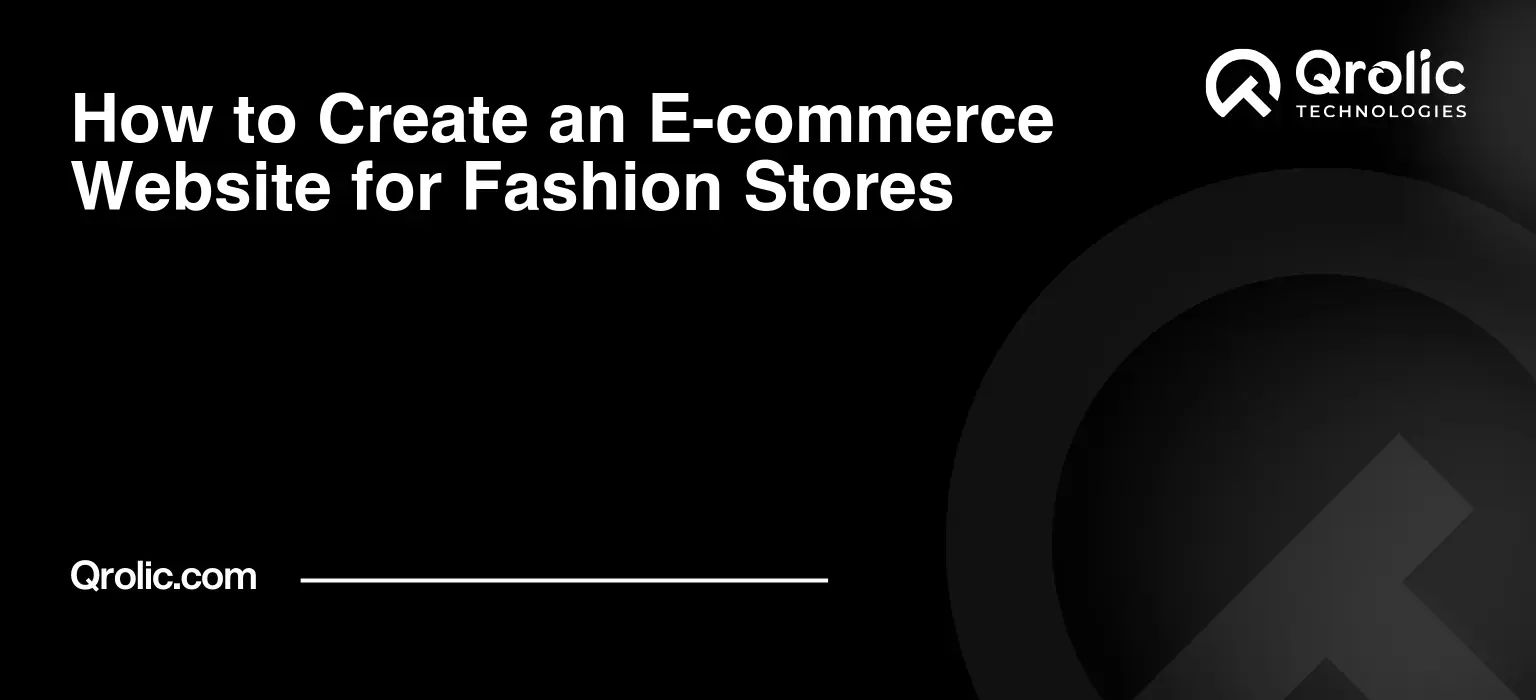Quick Summary:
- Plan your store by defining audience and goals.
- Pick the right platform and design a stunning website.
- Drive traffic using strong SEO and smart marketing.
- Manage inventory, orders, and provide great service.
Table of Contents
- The Allure of Online Fashion: Why an E-commerce Website is a Must-Have
- Why Choose E-commerce Over a Physical Store Alone?
- Planning Your Fashion E-commerce Website: Laying the Foundation for Success
- Website Infrastructure Planning: The Technical Backbone
- Choosing the Right E-commerce Platform: Powering Your Online Store
- Fashion Web Design: Creating a Visually Stunning and User-Friendly Experience
- Essential Website Pages: A Blueprint
- Fashion E-commerce SEO: Driving Organic Traffic to Your Store
- Keywords for Fashion E-commerce: A Starter List
- Marketing Your Fashion E-commerce Store: Reaching Your Target Audience
- Qrolic Technologies: Your Partner in E-commerce Success
- Managing Your Fashion E-commerce Store: Operations and Logistics
- Future-Proofing Your Fashion E-commerce Store: Staying Ahead of the Curve
The Allure of Online Fashion: Why an E-commerce Website is a Must-Have

The fashion industry thrives on trends, visibility, and accessibility. In today’s digital age, accessibility means having a strong online presence. Why is an e-commerce website crucial for fashion stores? It’s simple: your customers are online. An e-commerce platform allows you to reach a far wider audience than a brick-and-mortar store ever could, 24/7.
Expanding Your Reach Beyond Geographical Boundaries
Imagine your boutique’s style resonating with someone across the country, or even internationally. An e-commerce website eliminates geographical limitations, opening up your fashion store to a global market.
Boosting Brand Visibility and Recognition
A well-designed e-commerce website acts as a digital storefront, constantly promoting your brand and its unique identity. The more visible your brand, the more likely you are to attract new customers and build brand loyalty.
Providing a Convenient and Personalized Shopping Experience
Today’s consumers demand convenience. An e-commerce website offers a seamless shopping experience from the comfort of their homes. Personalized recommendations, tailored promotions, and easy navigation enhance customer satisfaction and encourage repeat purchases.
Gaining Valuable Customer Insights
E-commerce platforms provide a wealth of data about customer behavior, preferences, and purchasing patterns. This information can be used to optimize your website, refine your marketing strategies, and improve your product offerings.
Driving Sales and Increasing Revenue
Ultimately, the goal of any business is to increase sales and revenue. An e-commerce website provides a direct channel to customers, eliminating the need for intermediaries and maximizing profit margins.
Why Choose E-commerce Over a Physical Store Alone?
While physical stores offer a tactile and personal experience, they have inherent limitations:
- Limited Operating Hours: Online stores operate 24/7, unlike physical stores.
- Geographical Restrictions: Online stores reach a global audience, while physical stores are limited to their local area.
- Higher Overhead Costs: Physical stores incur significant costs such as rent, utilities, and staffing.
- Inventory Management: Managing inventory in a physical store can be challenging and costly.
An e-commerce website complements a physical store, expanding its reach and maximizing its potential. For startups or businesses looking to scale, an e-commerce platform can be a cost-effective and efficient solution.
Planning Your Fashion E-commerce Website: Laying the Foundation for Success
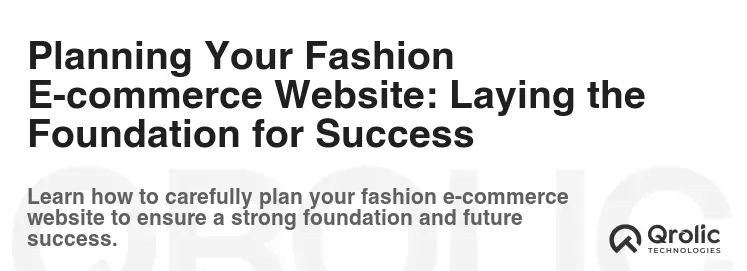
Before diving into the technical aspects, it’s crucial to develop a solid plan. This involves defining your target audience, choosing a business model, and creating a brand identity.
1. Define Your Target Audience: Who Are You Selling To?
Understanding your target audience is paramount. Ask yourself:
- Who are your ideal customers? (Age, gender, income, interests)
- What are their fashion preferences?
- Where do they shop online?
- What are their pain points and needs?
Creating detailed buyer personas will help you tailor your website’s design, content, and marketing strategies to resonate with your target audience.
2. Choose a Business Model: How Will You Operate?
Several business models are available for fashion e-commerce stores:
- Direct-to-Consumer (DTC): Selling directly to customers, controlling the entire brand experience.
- Dropshipping: Partnering with suppliers who handle inventory and shipping.
- Print-on-Demand (POD): Creating custom designs and having them printed on products only when ordered.
- Marketplace: Selling your products on established marketplaces like Etsy or Amazon.
Each model has its advantages and disadvantages. DTC offers greater control but requires more effort. Dropshipping and POD are low-risk but offer less control over product quality and shipping.
3. Develop a Strong Brand Identity: What Makes You Unique?
Your brand identity is what sets you apart from the competition. It encompasses your brand name, logo, color palette, typography, and overall aesthetic. Your brand identity should be consistent across all channels, including your website, social media, and marketing materials.
4. Conduct Market Research: What Are Your Competitors Doing?
Analyze your competitors’ websites, social media, and marketing strategies. Identify their strengths and weaknesses, and look for opportunities to differentiate yourself.
5. Define Your Product Catalog: What Will You Sell?
Clearly define the products you will offer, including sizes, colors, materials, and prices. Organize your products into categories and subcategories to make it easy for customers to find what they’re looking for.
6. Set Clear Goals and Objectives: What Do You Want to Achieve?
Establish specific, measurable, achievable, relevant, and time-bound (SMART) goals for your e-commerce website. Examples include:
- Increasing website traffic by 20% in the next quarter.
- Achieving a conversion rate of 2%.
- Generating $10,000 in sales per month.
7. Plan Your Marketing Strategy: How Will You Attract Customers?
Develop a comprehensive marketing strategy that includes:
- Search Engine Optimization (SEO): optimizing your website for search engines to attract organic traffic.
- Social Media Marketing (SMM): Engaging with your target audience on social media platforms.
- Email Marketing: Building an email list and sending targeted promotions and newsletters.
- Paid Advertising (PPC): Running paid advertising campaigns on Google Ads or social media platforms.
- Content Marketing: Creating valuable and engaging content to attract and retain customers.
Website Infrastructure Planning: The Technical Backbone
Before selecting a platform, consider these technical aspects:
- Domain Name: Choose a memorable and relevant domain name that reflects your brand.
- Web Hosting: Select a reliable web hosting provider that offers sufficient storage, bandwidth, and security.
- SSL Certificate: Secure your website with an SSL certificate to protect customer data.
- Payment Gateway: Integrate a secure payment gateway to process online transactions.
Choosing the Right E-commerce Platform: Powering Your Online Store
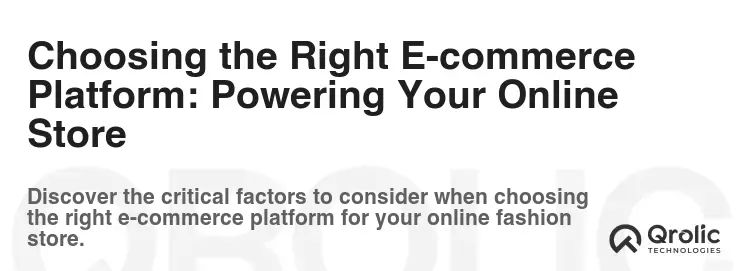
Selecting the right e-commerce platform is a critical decision. The platform you choose will determine the functionality, design, and overall user experience of your website.
1. Shopify: The All-in-One Solution
Shopify is a popular e-commerce platform that offers a comprehensive suite of tools for building and managing online stores. It’s known for its user-friendly interface, extensive app store, and excellent customer support.
- Pros:
- Easy to use and set up
- Wide range of themes and apps
- Integrated payment processing
- Excellent customer support
- Cons:
- Transaction fees apply (unless using Shopify Payments)
- Limited customization options compared to open-source platforms
- Monthly subscription fee
2. WooCommerce: The wordpress Powerhouse
WooCommerce is a free e-commerce plugin for WordPress. It’s a flexible and customizable platform that’s ideal for businesses that already use WordPress or want more control over their website.
- Pros:
- Free and open-source
- Highly customizable
- Large community and extensive documentation
- Integrates seamlessly with WordPress
- Cons:
- Requires more technical expertise to set up and maintain
- Can be more complex to manage than Shopify
- Requires separate hosting and security solutions
3. BigCommerce: The Scalable Solution
BigCommerce is a robust e-commerce platform that’s designed for businesses that are looking to scale. It offers advanced features such as multi-channel selling, inventory management, and marketing automation.
- Pros:
- Scalable and reliable
- Advanced features for multi-channel selling
- Built-in marketing tools
- Excellent customer support
- Cons:
- More expensive than Shopify or WooCommerce
- Can be complex to set up and manage
- Limited customization options compared to WooCommerce
4. Wix E-commerce: The Drag-and-Drop Option
Wix E-commerce is a user-friendly platform that allows you to build an online store using a drag-and-drop interface. It’s a good option for businesses that want a simple and visually appealing website.
- Pros:
- Easy to use drag-and-drop interface
- Visually appealing templates
- Affordable pricing plans
- All-in-one platform
- Cons:
- Limited customization options
- Less scalable than other platforms
- Limited features for advanced e-commerce functionalities
5. Squarespace E-commerce: The Design-Focused Choice
Squarespace E-commerce is a platform that’s known for its beautiful and minimalist designs. It’s a good option for fashion stores that want a visually stunning website.
- Pros:
- Beautiful and minimalist designs
- User-friendly interface
- All-in-one platform
- Excellent customer support
- Cons:
- Limited customization options
- Less scalable than other platforms
- Fewer features for advanced e-commerce functionalities
Comparing Platforms: A Quick Glance
| Feature | Shopify | WooCommerce | BigCommerce | Wix E-commerce | Squarespace E-commerce |
|---|---|---|---|---|---|
| Ease of Use | Very Easy | Moderate | Moderate | Very Easy | Easy |
| Customization | Moderate | High | Moderate | Low | Low |
| Scalability | High | Moderate | High | Low | Low |
| Pricing | Paid | Free (plugin) | Paid | Paid | Paid |
| SEO | Good | Excellent | Good | Moderate | Moderate |
| Support | Excellent | Community-based | Excellent | Good | Good |
Choosing the Best Platform for Your Needs
Consider these factors when choosing an e-commerce platform:
- Budget: How much can you afford to spend on the platform and its associated costs?
- Technical Expertise: How comfortable are you with setting up and maintaining a website?
- Scalability: Do you plan to scale your business in the future?
- Features: What features are essential for your business?
- Design: Do you want a visually appealing website?
- Support: Do you need reliable customer support?
Fashion Web Design: Creating a Visually Stunning and User-Friendly Experience
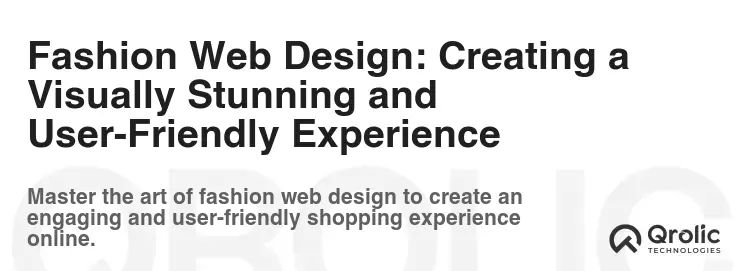
Your website’s design is crucial for attracting and retaining customers. A visually appealing and user-friendly website will encourage visitors to browse your products and make purchases.
1. Choose a Visually Appealing Theme: Setting the Tone
Select a theme that aligns with your brand identity and showcases your products effectively. Consider these factors:
- Color Palette: Choose colors that reflect your brand and appeal to your target audience.
- Typography: Use fonts that are easy to read and complement your brand.
- Layout: Choose a layout that is clean, organized, and easy to navigate.
- Imagery: Use high-quality images and videos to showcase your products.
2. Optimize for Mobile: Reaching Customers on the Go
Ensure that your website is mobile-responsive, meaning it adapts to different screen sizes and devices. Mobile commerce is growing rapidly, so it’s essential to provide a seamless shopping experience for mobile users.
3. High-Quality Product Photography: Showcasing Your Fashion
Invest in high-quality product photography that showcases your products in the best possible light. Use multiple images per product, including different angles and close-ups. Consider using lifestyle shots to show your products in context.
4. Clear and Concise Product Descriptions: Informing and Persuading
Write clear and concise product descriptions that highlight the key features and benefits of your products. Include information about materials, sizes, colors, and care instructions. Use persuasive language to encourage customers to make a purchase.
5. Easy Navigation and Search: Helping Customers Find What They Need
Make it easy for customers to find what they’re looking for by providing clear navigation and a robust search function. Organize your products into categories and subcategories, and use filters to allow customers to narrow down their search results.
6. User-Friendly Checkout Process: Minimizing Abandonment
Simplify the checkout process to minimize cart abandonment. Offer multiple payment options, provide clear shipping information, and allow customers to create accounts for faster checkout in the future.
7. Incorporate Social Proof: Building Trust and Credibility
Include social proof elements such as customer reviews, testimonials, and ratings to build trust and credibility. Encourage customers to leave reviews and testimonials after making a purchase.
8. Highlight Sales and Promotions: Driving Purchases
Prominently display sales and promotions on your website to encourage customers to make a purchase. Use banners, pop-ups, and email marketing to promote special offers.
Essential Website Pages: A Blueprint
- Homepage: The first impression. Feature your best-selling products, new arrivals, and promotions.
- Product Pages: Detailed information about each product, including images, descriptions, and pricing.
- Category Pages: Organized collections of products by type or style.
- About Us Page: Tell your brand story and connect with your customers.
- Contact Us Page: Provide contact information and a form for customers to reach out.
- FAQ Page: Answer frequently asked questions about your products and services.
- Shipping and Returns Page: Clearly outline your shipping and return policies.
- Privacy Policy Page: Explain how you collect and use customer data.
- Terms and Conditions Page: Outline the terms of use for your website.
Fashion E-commerce SEO: Driving Organic Traffic to Your Store
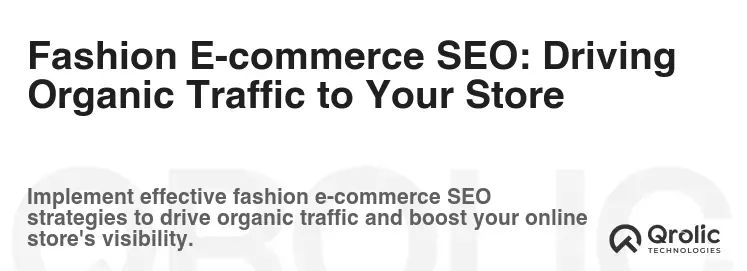
Search Engine Optimization (SEO) is crucial for attracting organic traffic to your website. By optimizing your website for search engines, you can improve your search engine rankings and increase visibility to potential customers.
1. Keyword Research: Identifying Relevant Search Terms
Conduct thorough keyword research to identify the search terms that your target audience is using to find fashion products online. Use tools like Google Keyword Planner, SEMrush, and Ahrefs to find relevant keywords with high search volume and low competition.
2. On-Page Optimization: Optimizing Your Website Content
Optimize your website content for your target keywords. This includes:
- Title Tags: Include your target keywords in your title tags.
- Meta Descriptions: Write compelling meta descriptions that encourage users to click on your website in search results.
- Header Tags (H1-H6): Use header tags to structure your content and highlight important keywords.
- Image Alt Text: Add descriptive alt text to your images, including your target keywords.
- Content Optimization: Write high-quality, informative, and engaging content that incorporates your target keywords naturally.
3. Off-Page Optimization: Building Authority and Trust
Build authority and trust by earning backlinks from high-quality websites. This includes:
- Guest Blogging: Write guest posts for other websites in your industry.
- Link Building: Reach out to other websites and ask them to link to your website.
- Social Media Marketing: Promote your website and content on social media platforms.
- Directory Submissions: Submit your website to relevant online directories.
4. Technical SEO: Ensuring Crawlability and Indexability
Ensure that your website is easily crawlable and indexable by search engines. This includes:
- XML Sitemap: Submit an XML sitemap to Google Search Console.
- Robots.txt File: Create a robots.txt file to prevent search engines from crawling certain pages.
- Website Speed: Optimize your website for speed to improve user experience and search engine rankings.
- Mobile-Friendliness: Ensure that your website is mobile-friendly.
- Structured Data Markup: Implement structured data markup to provide search engines with more information about your website content.
5. Content Marketing: Creating Valuable and Engaging Content
Create valuable and engaging content to attract and retain customers. This includes:
- Blog Posts: Write blog posts about fashion trends, style tips, and product reviews.
- Videos: Create videos showcasing your products and providing styling advice.
- Infographics: Create infographics that visualize data and information related to fashion.
- Guides: Create comprehensive guides on topics related to fashion.
Keywords for Fashion E-commerce: A Starter List
Consider these keywords for your fashion e-commerce website:
- General: Fashion, Clothing, Apparel, Accessories, Style, Trends
- Specific: Women’s Clothing, Men’s Clothing, Dresses, Shirts, Pants, Shoes, Bags, Jewelry, Sunglasses
- Brand-Related: [Your Brand Name], [Your Brand Name] Clothing, [Your Brand Name] Dresses
- Long-Tail: “Best women’s dresses for summer,” “Affordable men’s clothing online,” “Where to buy designer handbags”
- Location-Based: “Fashion store near me,” “Clothing boutique in [Your City]”
Marketing Your Fashion E-commerce Store: Reaching Your Target Audience
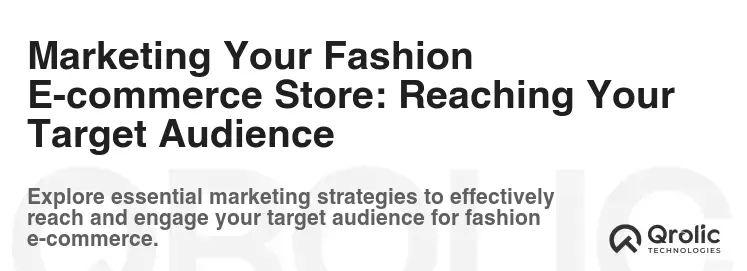
Marketing is essential for driving traffic to your website and generating sales. Develop a comprehensive marketing strategy that includes a variety of channels.
1. Social Media Marketing (SMM): Engaging with Your Audience
Engage with your target audience on social media platforms like Instagram, Facebook, Pinterest, and TikTok. Share visually appealing content, run contests and giveaways, and interact with your followers.
2. Email Marketing: Building Relationships and Driving Sales
Build an email list and send targeted promotions, newsletters, and product updates to your subscribers. Segment your email list based on customer preferences and behavior to personalize your messaging.
3. Paid Advertising (PPC): Reaching a Wider Audience
Run paid advertising campaigns on Google Ads and social media platforms to reach a wider audience. Target your ads based on demographics, interests, and keywords.
4. Influencer Marketing: Leveraging Social Influence
Partner with influencers in the fashion industry to promote your products to their followers. Choose influencers who align with your brand values and target audience.
5. Content Marketing: Attracting and Retaining Customers
Create valuable and engaging content to attract and retain customers. This includes blog posts, videos, infographics, and guides.
6. Affiliate Marketing: Partnering with Other Businesses
Partner with other businesses to promote your products through affiliate marketing. Offer them a commission for every sale they generate.
7. Public Relations (PR): Building Brand Awareness
Reach out to journalists and bloggers to get your brand featured in publications and online articles.
8. Events and Pop-Up Shops: Creating a Physical Presence
Participate in fashion events and set up pop-up shops to create a physical presence and connect with customers in person.
Qrolic Technologies: Your Partner in E-commerce Success
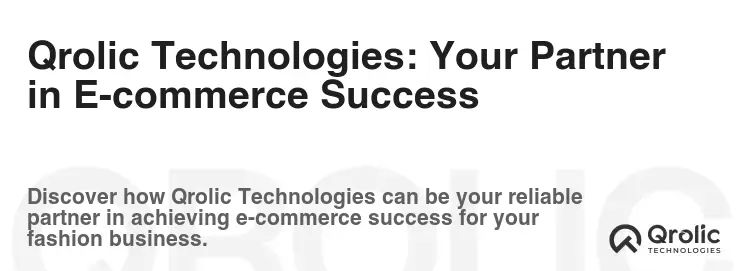
Qrolic Technologies is a leading provider of e-commerce solutions, offering a wide range of services to help businesses build and grow their online stores. We specialize in:
- E-commerce Website Development: We design and develop custom e-commerce websites that are visually appealing, user-friendly, and optimized for conversions.
- E-commerce Platform Integration: We integrate your e-commerce website with leading platforms like Shopify, WooCommerce, and BigCommerce.
- SEO and Digital Marketing: We help you drive traffic to your website and generate sales through our comprehensive SEO and digital marketing services.
- Mobile App Development: We develop mobile apps for your e-commerce store to provide a seamless shopping experience for mobile users.
- E-commerce Consulting: We provide expert consulting services to help you develop and implement a successful e-commerce strategy.
Why Choose Qrolic Technologies?
- Experienced Team: We have a team of experienced e-commerce professionals who are passionate about helping businesses succeed online.
- Custom Solutions: We provide custom solutions that are tailored to your specific needs and goals.
- Results-Driven Approach: We are focused on delivering measurable results that drive business growth.
- Excellent Customer Support: We provide excellent customer support to ensure your satisfaction.
Contact us today to learn more about how Qrolic Technologies can help you create a successful fashion e-commerce store.
Managing Your Fashion E-commerce Store: Operations and Logistics
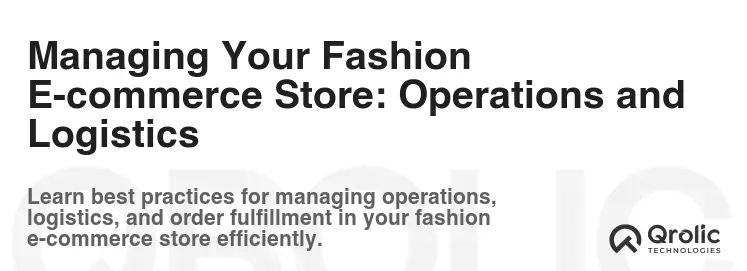
Once your website is live, it’s crucial to manage it effectively to ensure smooth operations and customer satisfaction.
1. Inventory Management: Tracking Your Stock Levels
Implement an inventory management system to track your stock levels and prevent stockouts. Use software or spreadsheets to manage your inventory, and set up alerts to notify you when stock levels are low.
2. Order Fulfillment: Processing and Shipping Orders
Establish a streamlined order fulfillment process to process and ship orders quickly and efficiently. This includes:
- Order Confirmation: Sending order confirmation emails to customers.
- Payment Processing: Processing payments securely.
- Order Packing: Packing orders carefully and securely.
- Shipping: Shipping orders promptly and providing tracking information to customers.
3. Customer Service: Providing Excellent Support
Provide excellent customer service to resolve customer issues and build loyalty. Respond to customer inquiries promptly and professionally, and offer helpful solutions.
4. Data Analytics: Tracking Your Performance
Track your website’s performance using data analytics tools like Google Analytics. Monitor key metrics such as website traffic, conversion rate, and sales revenue to identify areas for improvement.
5. Security: Protecting Your Data and Customers
Implement security measures to protect your website and customer data from cyber threats. This includes:
- SSL Certificate: Installing an SSL certificate to encrypt data transmission.
- Firewall: Implementing a firewall to prevent unauthorized access.
- Regular Backups: Backing up your website data regularly.
- Security Updates: Keeping your software and plugins up to date.
6. Legal Compliance: Adhering to Regulations
Ensure that your website complies with all relevant legal regulations, including data privacy laws, consumer protection laws, and tax laws.
Future-Proofing Your Fashion E-commerce Store: Staying Ahead of the Curve
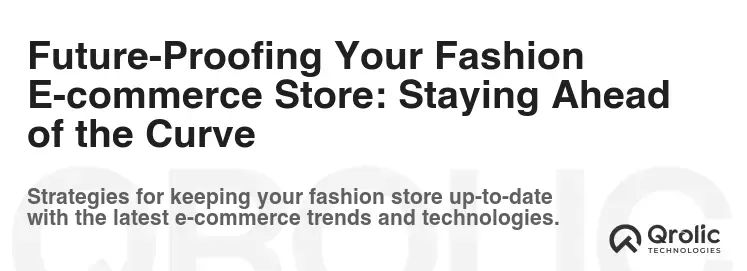
The e-commerce landscape is constantly evolving, so it’s essential to stay ahead of the curve and adapt to new trends and technologies.
1. Personalization: Tailoring the Experience
Implement personalization strategies to tailor the shopping experience to individual customers. This includes:
- Personalized Recommendations: Recommending products based on customer browsing history and purchase behavior.
- Targeted Promotions: Offering targeted promotions based on customer demographics and interests.
- Customized Content: Providing customized content based on customer preferences.
2. Artificial Intelligence (AI): Enhancing Efficiency
Leverage artificial intelligence (AI) to enhance efficiency and improve customer experience. This includes:
- Chatbots: Using chatbots to provide customer support.
- Product Recommendations: Using AI to generate personalized product recommendations.
- Fraud Detection: Using AI to detect and prevent fraud.
3. Augmented Reality (AR): Enhancing the Shopping Experience
Consider incorporating augmented reality (AR) to enhance the shopping experience and allow customers to virtually try on clothes or visualize products in their homes.
4. Sustainability: Embracing Ethical Practices
Embrace sustainable and ethical practices to appeal to environmentally conscious consumers. This includes:
- Sustainable Materials: Using sustainable materials in your products.
- Ethical Sourcing: Sourcing your products from ethical suppliers.
- Eco-Friendly Packaging: Using eco-friendly packaging materials.
5. Multi-Channel Selling: Reaching Customers Everywhere
Expand your reach by selling your products on multiple channels, including your website, social media platforms, and online marketplaces.
By planning, designing, and managing your fashion e-commerce website effectively, you can create a successful online business that reaches a global audience and drives revenue growth. Remember to continuously analyze your performance, adapt to changing trends, and prioritize customer satisfaction. Good luck!
